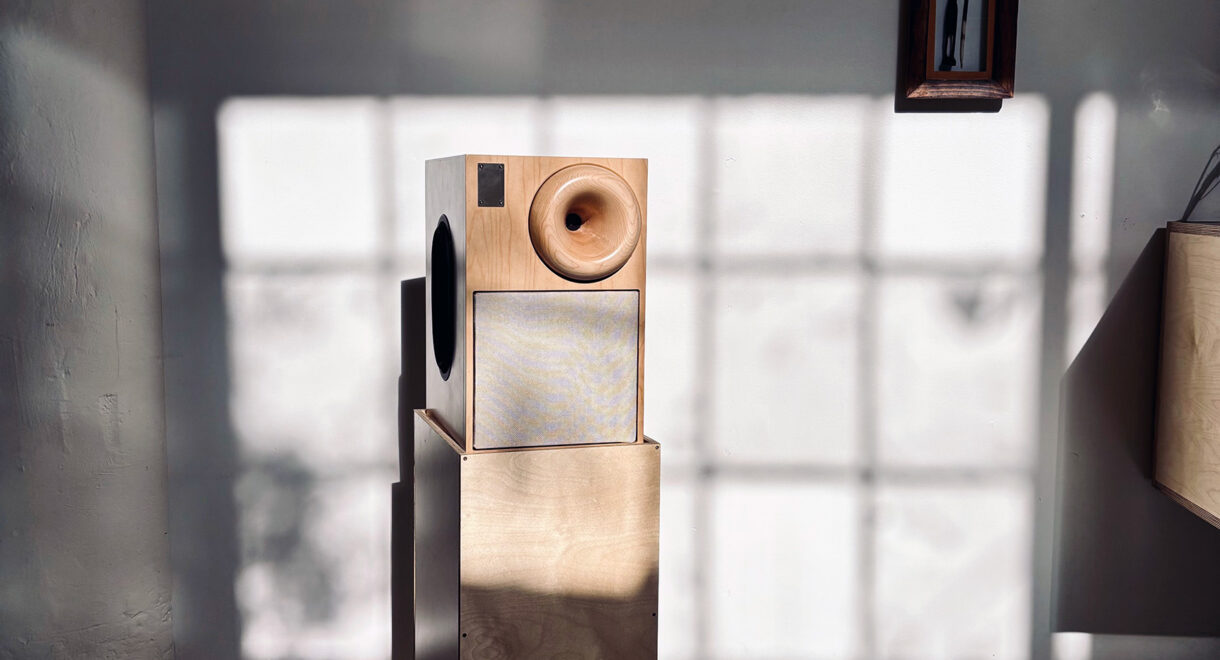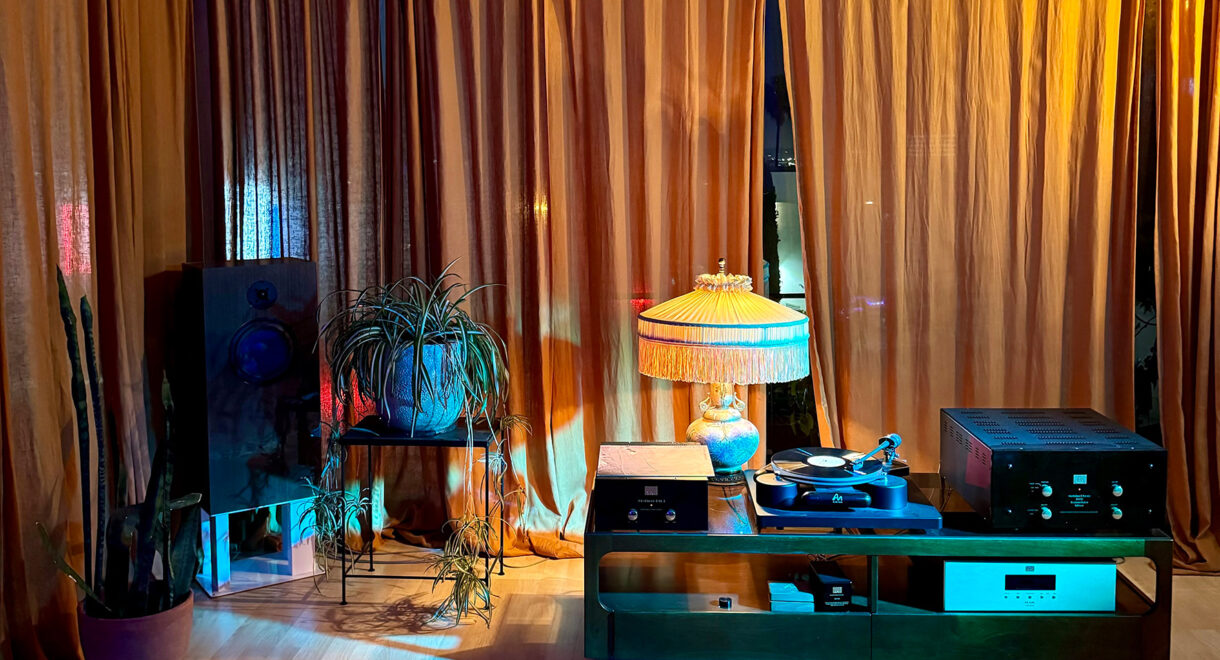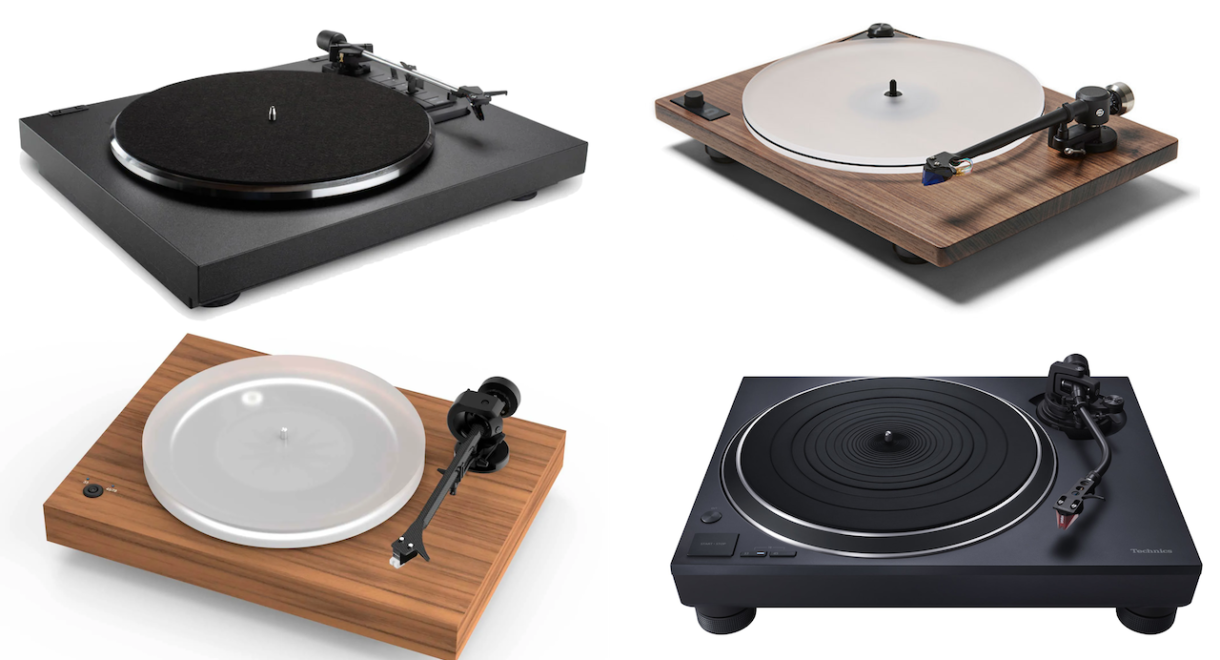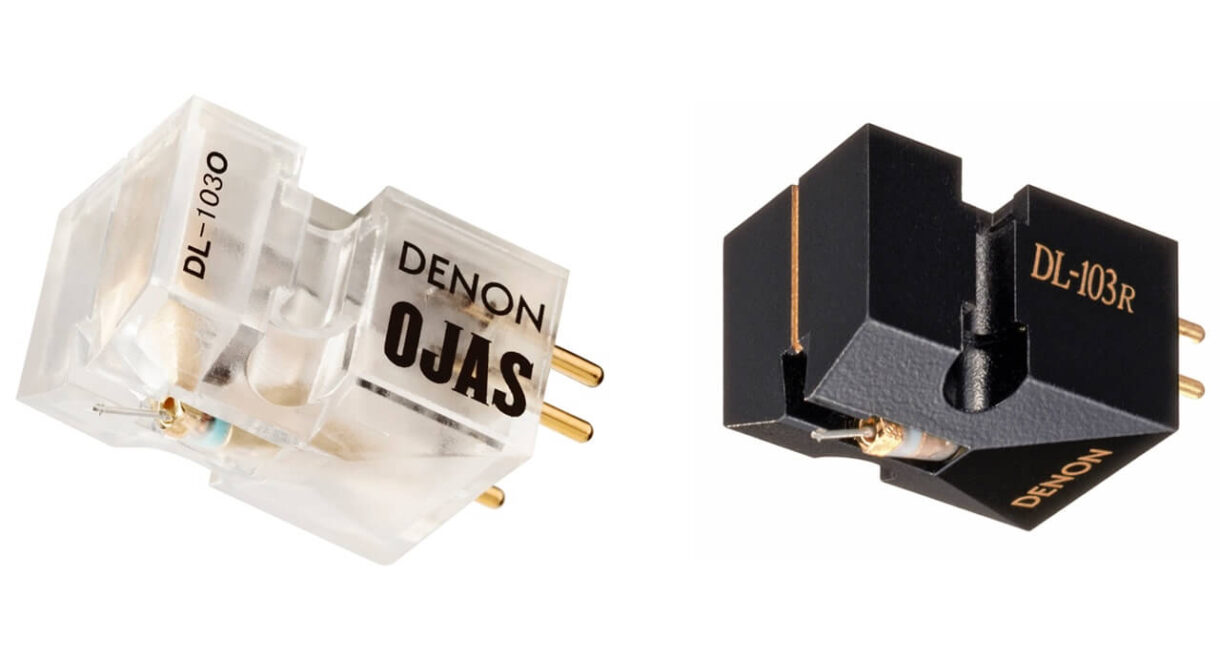Transparent clarity, deep bass, and “Invisible Sound” from German audio company ADS. Background: One of the lesser known hi-fi brands of the ’70s, ADS (Analog and Digital Systems) […]
Discrete Circuits: An Interview with Condesa Electronics Founder Mehdi El-Aquil

ISC sits down with Condesa Electronics founder Mehdi El-Aquil to talk mixers, how Condesa came to be, and the future of rotaries.
Based in Adelaide, Australia, Condesa Electronics in the past decade has been quietly assembling some of today’s most sought-after hi-fi DJ mixers and equalizers. Crafted by hand with an emphasis on clear and present sound, Condesa takes cues from the iconic makes of the past and arguably rivals those great rotary models it’s aspiring to.
Since its humble beginnings, the boutique mixer makers have found fans in respected DJ acts such as Marcellus Pittman, Sadar Bahar, and Palms Trax. Its machines have piloted the dance world’s greatest booths and facilitated intimate deep listening rooms across the globe. We had a Condesa Carmen at the In Sheep’s Clothing hi-fi listening bar.
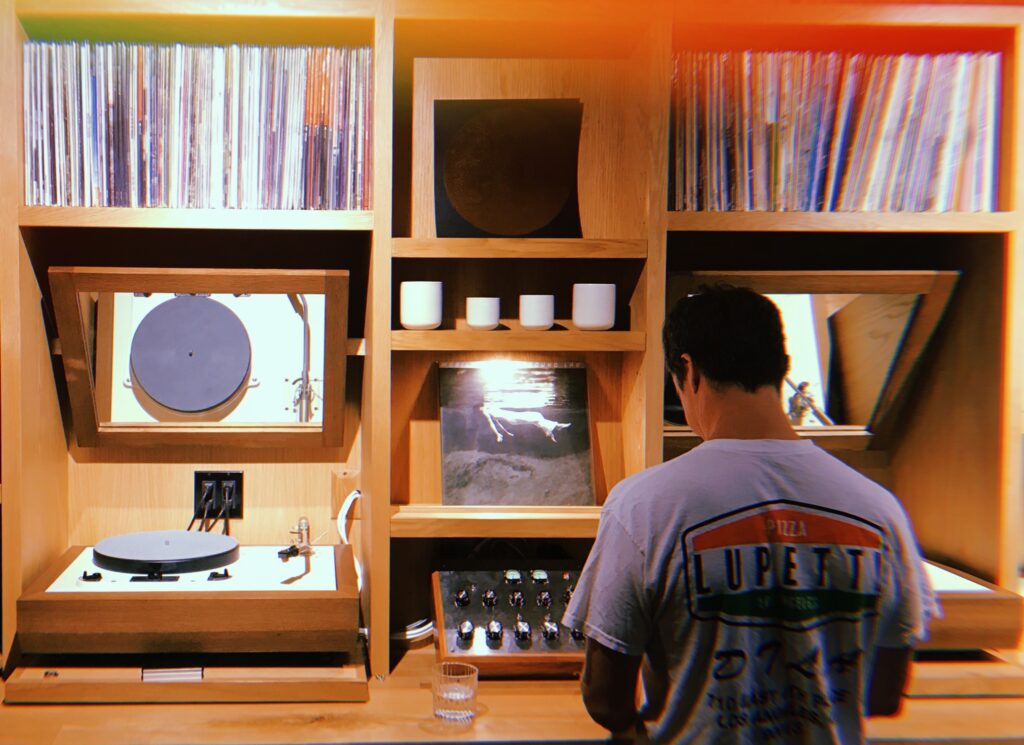
Our conversation details Mehdi’s trajectory into discrete circuits, from the small electrical bits of his youth to discovering the ultrasimple yet beautifully colored signal paths of the great seventies rotary mixers. We touch on Condesa’s future, the “rotary cult” and how desperation for a coveted sound spawned one of Australia’s greatest musical exports.
This conversation has been edited for length and clarity.
In Sheep’s Clothing: To dive in, I’d really love to hear Condesa’s “origin story,” how did it all start?
Mehdi: Basically, I was always interested in pulling things apart and putting them back together when I was a kid. I remember ruining some watches, wearing them in the bath (laughs), then taking them out, drying them up, and trying to get them to work again. Little remote cars and stuff. I had an interest in electronics. I was into art as well, so I wanted to be a bit creative with things. But yeah, I was obsessed with batteries, light bulbs and motors and how they could work together. I remember finding some in school. I was put in detention or something funnily enough, and I was put in a room. I was bored, I’d done my lines, and I found this box with electrical bits, and I started connecting them and began playing around with that stuff.
When did that evolve into building music-related equipment?
When I left school, I got an apprenticeship in electronics that had nothing to do with musical stuff. I was into music, from breakdancing and electro music, how all that was mixed together. That really caught my imagination. I was into music and when I left school I was trying to DJ, and just you couldn’t get stuff like that. The first DJ mixer I got, when I was about 17, was a Phonic DJ mixer and I had to order through a PA shop and it took ages to turn up. I had two really crap turntables, one Technics that took me a long time to save up for and I had a rubbish sort of belt-driven various speed deck, and for a long time that was my set up (laughs).
I think growing up in that era and not having affordable DJ products made it happen. Like, you can make something. That’s kinda how I got into electronics and wanting to make bits. I always had jobs in electronics like setting up sound systems. Eventually, electronics went away from average jobs and I started working on sound systems and repairing stuff. I saw a lot of how things could fail. That helped me a lot when I started building mixers myself.
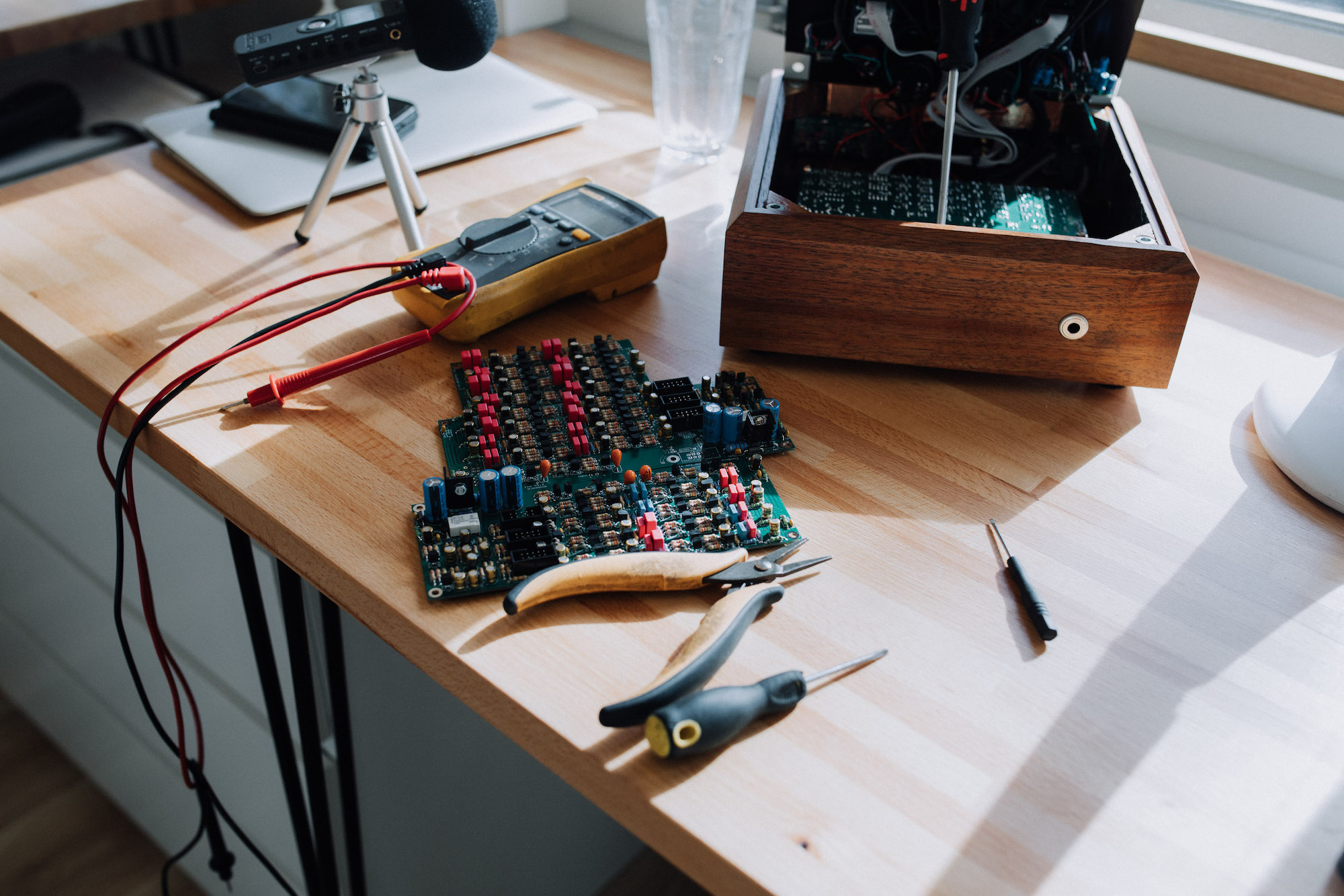
It’s funny, Ikutaro Kakehashi, who created Roland, also started with watches. I love how a lot of these respected electronic engineers all started there.
Yeah, it’s amazing, maybe it’s a craft thing or needing to concentrate and see how things come together on small detailed things.
Seems like a simple entryway, for sure.
Yeah, definitely. And I think it applies to that sort of thinking in the end. Electronics was never hard for me. Like, there was just a nice overview, the same with math. I know it scares a lot of people, but I could always think of shortcuts through the numbers and ways to simplify that wasn’t the “official” way to do it. So yeah, that side of things wasn’t that hard. And I remember looking at electronics and seeing them, to be able to see them as blocks. “That bit is the preamp and this bit is the mixer and this bit is the output.”
Was there a mixer that you discovered in that early period that inspired you to start building your own?
Really there’s two, and it was much later running into all of this. I did electronics. I left school in ‘87 at the age of 16 and started doing an apprenticeship that took me ages to actually get that job and then I was doing electronics full stop. And at that age, I was into collecting records and attempting to DJ, I say attempting, because I mean, unlike now it seems that because of online courses and stuff, people can learn how to DJ quite quickly.
It took me about two years of practicing and recording mixes at home to get to some proficiency. Every day I would get up or every evening I would get back from work and mess around. Maybe sometimes it was the same four records trying to put them together, trying to work out really bad, wrong mixes (laughs). Yeah, but learning techniques. I always used to use fader mixers. And I got introduced to the idea of rotary mixers, it must have been around 2008. I was reading, looking up stuff like the history of the original discos and clubs. I did know before then the Ureis and Bozaks, I knew of them, but I never was able to put my hands on one and test it. And I remember, I got my hands on a Bozak here, for a club owner — a friend of mine that actually bought one to put in the club and I needed to service it. I listened to it and I was really impressed by the original ‘70s circuitry and how amazing it sounded. At the same time, I’d been making studio equipment, I’d be making clones of compressors and micro-pre’s from the same era that use discrete circuitry. So I knew a lot about the circuitry and how these simpler circuits sounded so much better than a lot of the newer stuff. That blew me away.
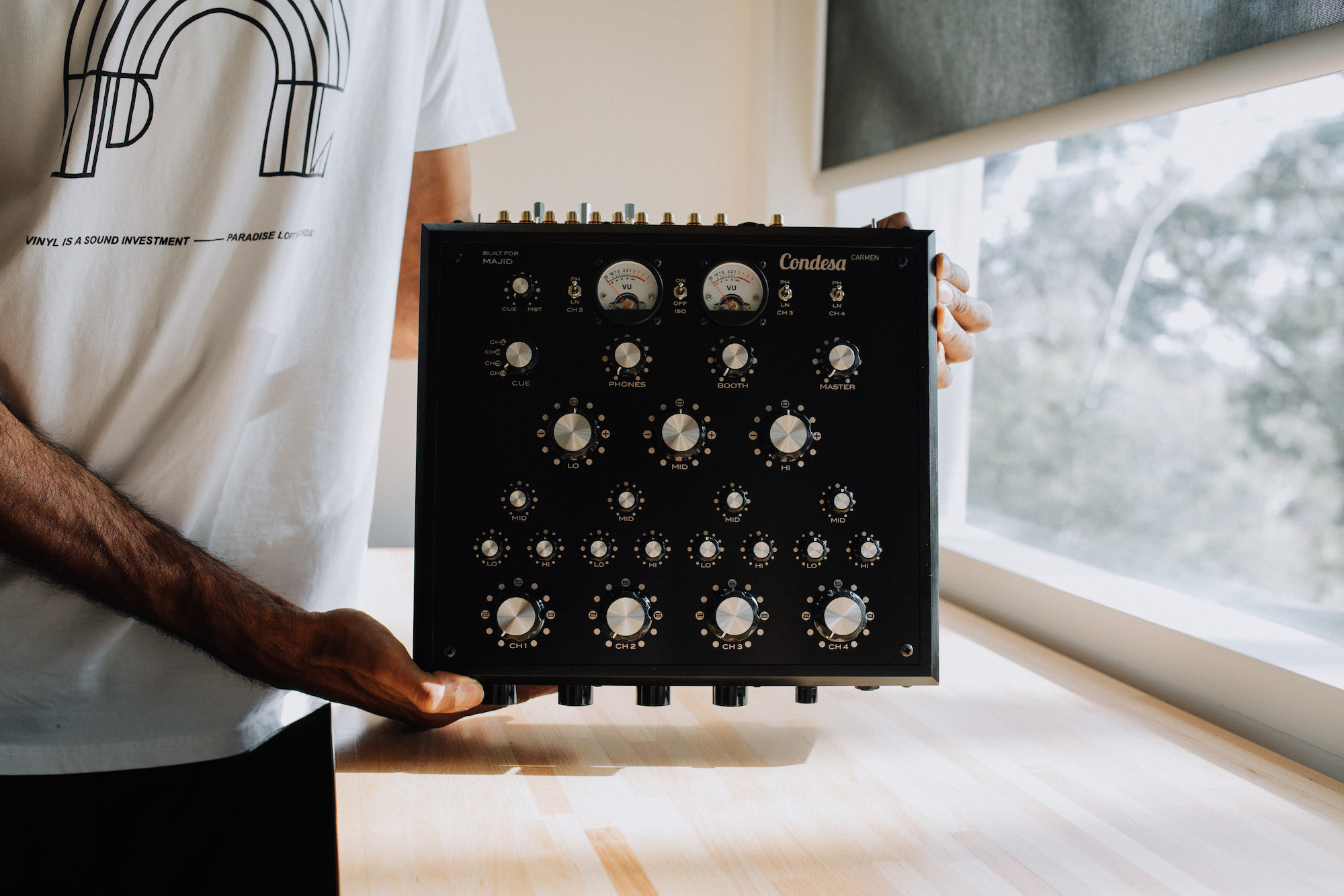
That's discrete circuits versus integrated circuits?
Yeah, but that said, I also worked on an Urei 1620 as well and that sounded amazing. And that does have integrated circuits, but it has a blend of integrated circuits and discrete circuits. But the signal path, once again, is minimal. There’s not much in the signal path. I remember checking a Rane scratch mixer at the time. A TM 52 or something like that. And from the beginning, from the first input to the last output, it went through, I can’t remember but a ridiculous amount of operational amplifiers — 27 of them in the signal path! Even though each little microchip has super good noise and distortion figures and everything else, it degrades it a tiny bit, and even if there’s 27 of them they can still sound good. But when you put it against something like an Urei 1620 or an original Bozak, it’s day and night.
I'm a bit of a novice when it comes to mixer builds and circuitry, but for faders and rotaries, is there a simple way to distinguish them? Other than a smaller signal chain, and obviously the knobs versus the faders..
I mean the knobs versus faders. But in my thinking, it’s really just a different approach. Both of them are valid, I wouldn’t say one is better than the other. It depends on the person. Like horses for courses, tea versus coffee, it depends on the person using it. But I think if you’re making the switch, being able to put yourself forward as a DJ and say, look this is what I can do: the faders allow me to do this, this and this, and I think when you make a choice to go to rotary, you’re saying hold on a second, I’ll put what I can do technically aside. What I want to be first and foremost, at the front, is the best sound quality. I want it to sound as best as it can. And I think that’s the distinction that rotaries versus faders usually makes. There can be fader mixers that can be as good sounding or have exactly the same circuitry as a rotary mixer. It just doesn’t seem to happen as much.
It seems like a lot of companies are starting to make them too. Resident Advisor wrote an article a few years back called “The Cult of Rotary Mixers.” What are your thoughts on the rotary boom? At the same time, it may not just be a DJ thing. There really seems to be a collective, growing desire for higher quality audio.
What I used to say was, ‘Wow, we were really lucky to start making mixers when we did, to catch this wave. This was really good.’ And then I thought about it a second time and I thought, ‘No, actually, maybe we just added some water to that wave. Maybe what we’re doing at Condesa is a small part of this growth. So we’ve contributed to it rather than just being lucky and being in the right place to jump on it. We’re one of the companies that inadvertently helped to grow this thing. So I think it’s really good. I think if anyone that’s into music is going, ‘Can I get it to sound better? Can I have the experience of listening to it?’ It’s the same in venues. If I go to a venue, so many of them are badly set up for sound.
Really nothing worse than a great room with a terrible setup.
Happens all the time, when you find yourself in a great venue, even if you weren’t dancing, ultimately, it’s the music. My thinking is, I want the music not to bash you over the head, not to drag you onto a dance floor, not to force you into anything, but to seduce you. I want the sound to be seductive. I want it to catch you. So you’re like, ‘Wow, I’m going to get a bit closer to this. This is a good feeling. You know, it’s not a bad feeling. It’s not a hurtful feeling. It’s not giving me a headache.’ I mean, a lot of that counts on the source music being played, of course.
That’s one thing with the discrete circuitry. It has a clear presence. Discrete circuitry can be as good or bad as the design, but if we go into what we make, it has clear highs. They have presence but they’re not aggressive. There are so many times I’m out and I hear top end, sharp, and cutting like that (stabbing motion). And it’s like, Whoa. Even when you EQ it, even if you go up to the front-of-house mixer and you turn the highs down, it’s still there! That aggressive top end is horrible.
There is a lot of bad audio out there. And if people move into rotary mixers means that they’re going to a place where they’re really listening, it can only enhance the enjoyment of the music. Another way to think about it is if a Condesa makes you, the music lover, the DJ, have a better connection to the music or the listeners have a better connection to the music then our job’s done. If the connection’s better — if people turn up at a venue or come to someone’s house and play some records, or even digital that’s mastered well and goes ‘Wow. I spent my whole night really listening to stuff that I had and never realized how good it sounded, then our job’s done. That’s really the price of it.
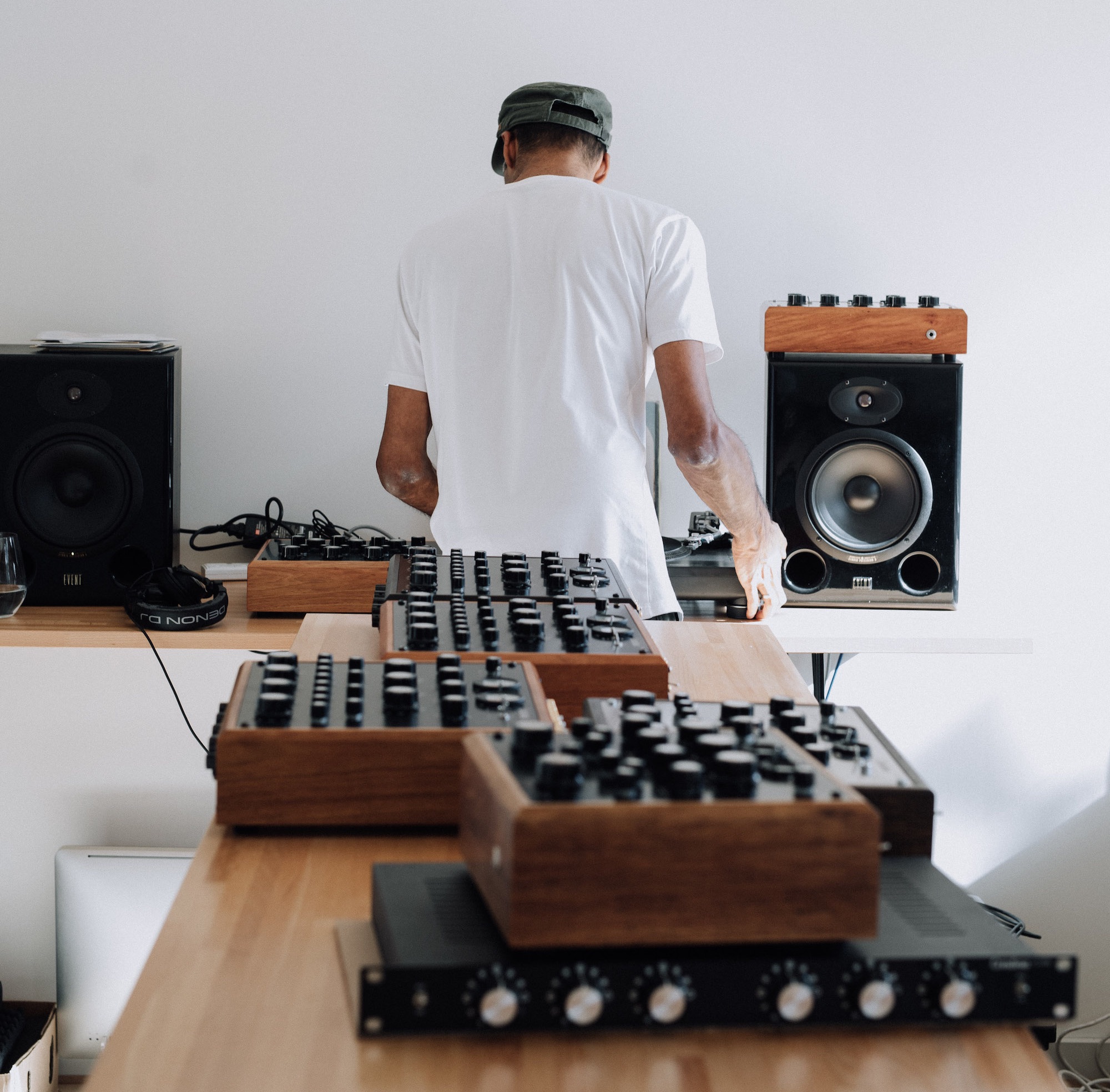
Did you happen to make it down to that Fairfield Amphitheatre show recently with Marcellus Pittman?
I didn’t! No, I didn’t see it.
I saw a few clips and the setup looked amazing. Thought you might’ve had something to do with it.
Yes. I spoke to him about it. That was brilliant, used all Klipsch speakers. He’s been staying over here for awhile and I’ve caught up with him and Driller for dinner the other week. And I think he’s back over this weekend, so I’m going to go and check him on Saturday night, but yeah, the Fairfield setup looked amazing.
Think they had La Scala's as monitors. When I saw that I was just like, oh my god.
Yes! They really went to town! I spoke to the guy who set it up and he was asking me about levels with the mixer to try and get the volumes right, too and it seemed to work really well. I heard it was an amazing vibe, really rich sound.
Do you have any ideal speakers in mind in the design of these? I mean, it seems that Klipsch and Condesa are a perfect marriage.
Yeah, that’s a nice mixture. I don’t, what I would say with the Condesas, like people say, “Oh, it’s really colored. It’s really colored.” But it’s pretty flat. I mean, the isolator does add some peaks to the sound but there’s a bypass switch. That means that the sound is quite flat. But what people don’t realize is the Condesas run all the way down to 10 Hertz. So you’ve got extended bass and even if you don’t have bass there, you have the harmonic subsonics there that most manufacturers are rolling their bass off of 30 Hertz. They’re cutting that 20 Hertz off. And I know we’re only meant to hear to 20 Hertz, but it’s open. I’m not going to change that design but that makes a big difference if the system’s set up right.
So full-range speakers are what I think would sound really good. I’ve never had an ultimate idea, but when I hear how fast and reactive the Klipsch speakers are, they sound really good. But I also think that they do need some extra support for subsonics and modern music too, just to give it that little extra oomph if it’s a dance vibe. But if it’s set up in a listening room and they’re in the corners of the room, they could work beautifully.
It really does, that's what we had in our space. Klipschorns and a Carmen.
Yeah, that looked brilliant. That setup was so amazing. I was planning to come over, but this whole covid nightmare.
Hope you guys were alright during the pandemic and were still able to operate and fulfill orders safely.
Yeah. It was weird for the first month. It was quiet, we didn’t get one email and I was like, okay, all right, this is how it’s going to go. Let’s just batten down the hatches, catch up with what we want to do and put one foot in front of the other. And then after that, bam, the next month went crazy. It was twice the amount of orders and it’s been busier than ever, ever since really.
Yeah, I feel like a lot of people turned to music during this time, started to approach it differently, and rethinking their home setups... I'm sure a lot of people sought you guys out for that.
Have you seen people buy more vinyl and wanting to buy different, more broad music, and good home listening music?
We have a very humble, curated selection so it's not a great way to gauge, but I do know of a lot of people that refined their personal systems due to all of the home-time. Even me, I bought a.... I'm so sorry…. A _____ mixer.
That’s alright! (Laughs) That’s a great mixer and actually, they’re really good value. Yeah. That’s amazing.
I'm saving up for a Carmen V. You’ll see my order in a few months. (laughs)
Still, it’s the same movement and I really had to think this through and it took a bit of time. Cause I think I used to feel quite a bit of pressure when new mixers and other things got introduced. And then I thought to myself, I’m being really precious about this. You know, this is an open market and there are plenty of good mixer designers out there.
Has the Condesa operation grown? Are you still building everything yourself?
Yeah, I can’t build everything myself, we have help. We’ve got a crew, there’s about five of us which is great. Everything’s done here locally in South Australia, we get the circuit boards in, we get the parts in, and the guys begin to solder and populate. Everything’s done by hand, solder and populate the boards. Looms are made up. Someone draws out the wood and lines it, faceplates have controls put on, wirings put together with the circuit boards, mostly done by Dave, my right-hand man. We’ll do batches of 10. Everything comes from me even if I’m not building every one of them.
I’ve been really enjoying your guys’ mix series. (Discrete Circuits)
Yeah, Lauren’s been running that and sort of picking stuff. I know a lot of people kind of approach me and say, Oh, can I do a mix? I’ve got a mix. Lauren’s on quality control. So I can’t undermine what she’s doing. It’s been a nice series. One quick thing about the mix series is our connection to, if I could use the term, the scene and DJing. Like, digging and discovering new music and discovering old music, vinyl, but also digital, all mediums – it doesn’t matter. But our connection to all of that is really strong. It’s really an important part of it. We’re not doing it to feed off of that. We’re doing it because we believe we’re part of it as DJs and music lovers too. I’m referring to, say, maybe me, Lauren, and how the ethos of the company is, otherwise I wouldn’t have made a mixer. The reason I made one is because I looked at the Ureis and Bozaks and I said, ‘I’m fucked! I can’t afford one of those, and I really want one but hold on, I can make one.’ That’s where it all came about. Like, this is a side effect of liking the music and wanting technology that can work with the music rather than, ‘Oh, let’s make a mix series and let’s infiltrate ourselves in this scene to be seen as part of it, to sell more mixers. No, forget that, we feel we’re part of it.
Yeah, during those early years, was there a person, a DJ, someone you looked up to that you were really excited about who bought your mixer. Someone that made you realize, like, oh I’m actually doing something pretty cool here?
Yeah. There were several. And sometimes it would just be like email inquiries. And even if they didn’t follow through, there were several that really excited me and was like, “Wow, this is coming full circle because I’ve been buying this person’s records for ages. And now they’re asking for a mixer. This is crazy.” So it happens all the time. Even now it happens. But I guess one of the first people, was maybe Marcellus himself, he went, “Oh, I want a Carmen, but you need to put an isolator in it for me.”
I was always gonna do it, it was always in the cards for me to get to there, but him saying that really pushed me to go, all right, I’ll get it done. And I’ll do it on the strength of him asking me. That was a good, inspirational shove to get me to develop it. So, yeah, he was definitely a big one, but there have been lots of different artists and DJs that I’ve looked up to now that have bought mixers. And there’s sometimes I didn’t even realize, and I’ve seen stuff posted, Oh, that’s the person that owns that label. I didn’t even realize that. Wow.
Yeah, I feel like I see them everywhere.
Yeah. And I think we’re looking at about a thousand mixers out there now, and next year will be 10 years, 10 years of making them.
Wow, that’s great. I think we only have time for one more question, so I'll keep it pretty simple. What have you been listening to lately? Any records you wanna shout?
Yeah. So I’ve been listening, I’ll just show you this one actually, I’ve been listening to this. This new Emanative LP that just dropped about a month ago, that’s been brilliant. It’s pretty jazzy, pretty laid back.
And apart from that, I’ve been buying a lot of older used reggae. And I just got the reissue of this African Head Charge album.
We're all about the On-U over here.
Yeah, like all the On-U I’m working my way through it. And I also like this, album here. I don’t know if you’ve got it, you might have.Oh yeah, the new Time Capsule.
Yeah, Gabrielle Roth & the Mirrors. That’s beautifully recorded too. I love the sound of that.
And apart from that, I’ve been buying obscure bits of house music from the late eighties and nineties. Not necessarily even expensive bits, but just bits that have been sort of catching my ear and “I need a copy of that.” Some early British bits and pieces too. At some point I’m going to put a brit funk mix together. I’ve been promising my friend I’ll be doing it. And I’ve been, building the pile up, just stuff that sounded pretty funky and loose that started from about 78 to about 83, 1983. There was this burst of really nice jazz-funk and brit-funk. And then it sort of just disappeared as drum machines came in. So yeah, I’m working on compiling this mix.Excited to hear it.
Learn more about Condesa here: https://condesaelectronics.com/
Follow Condesa: https://www.instagram.com/condesaelectronics/





